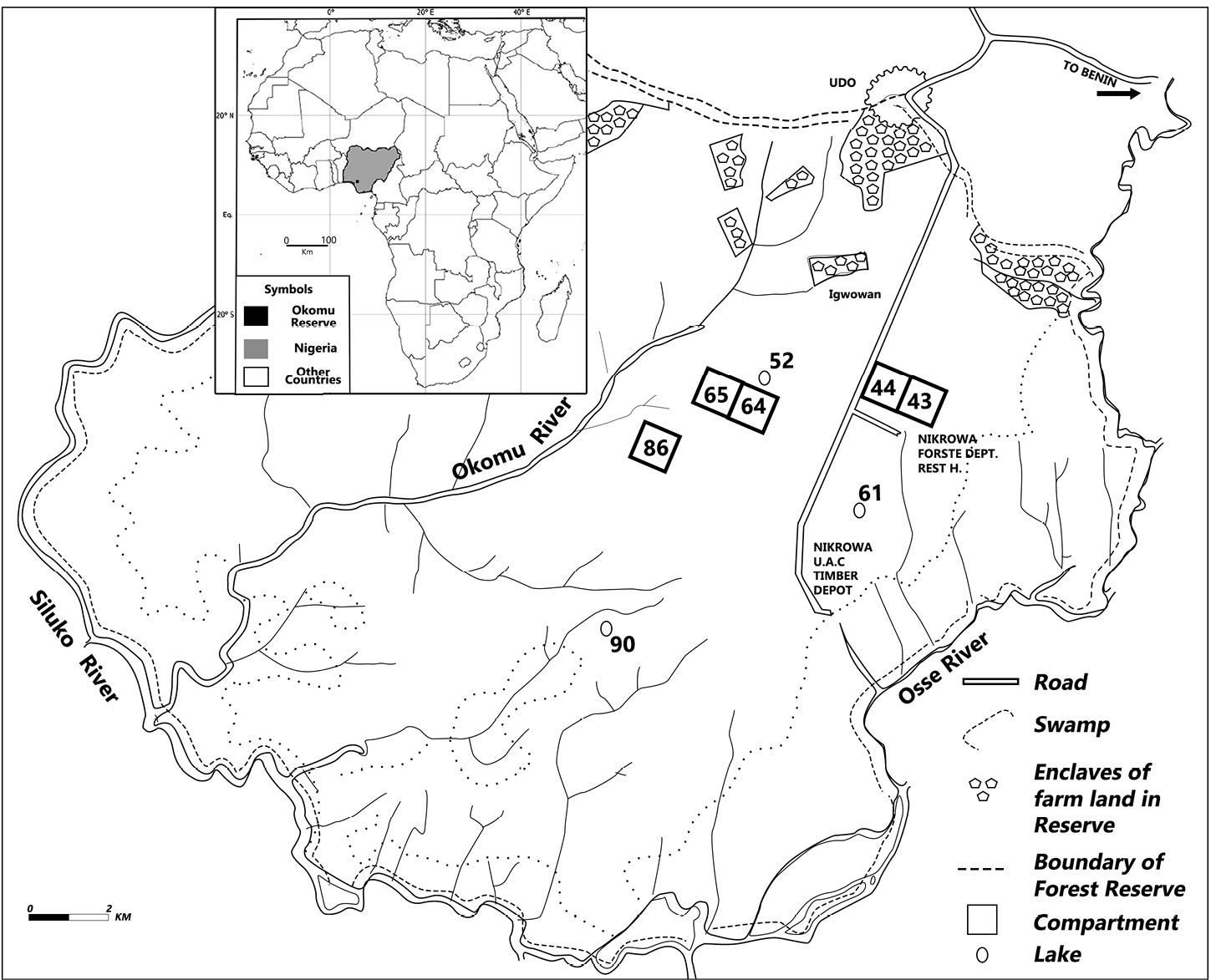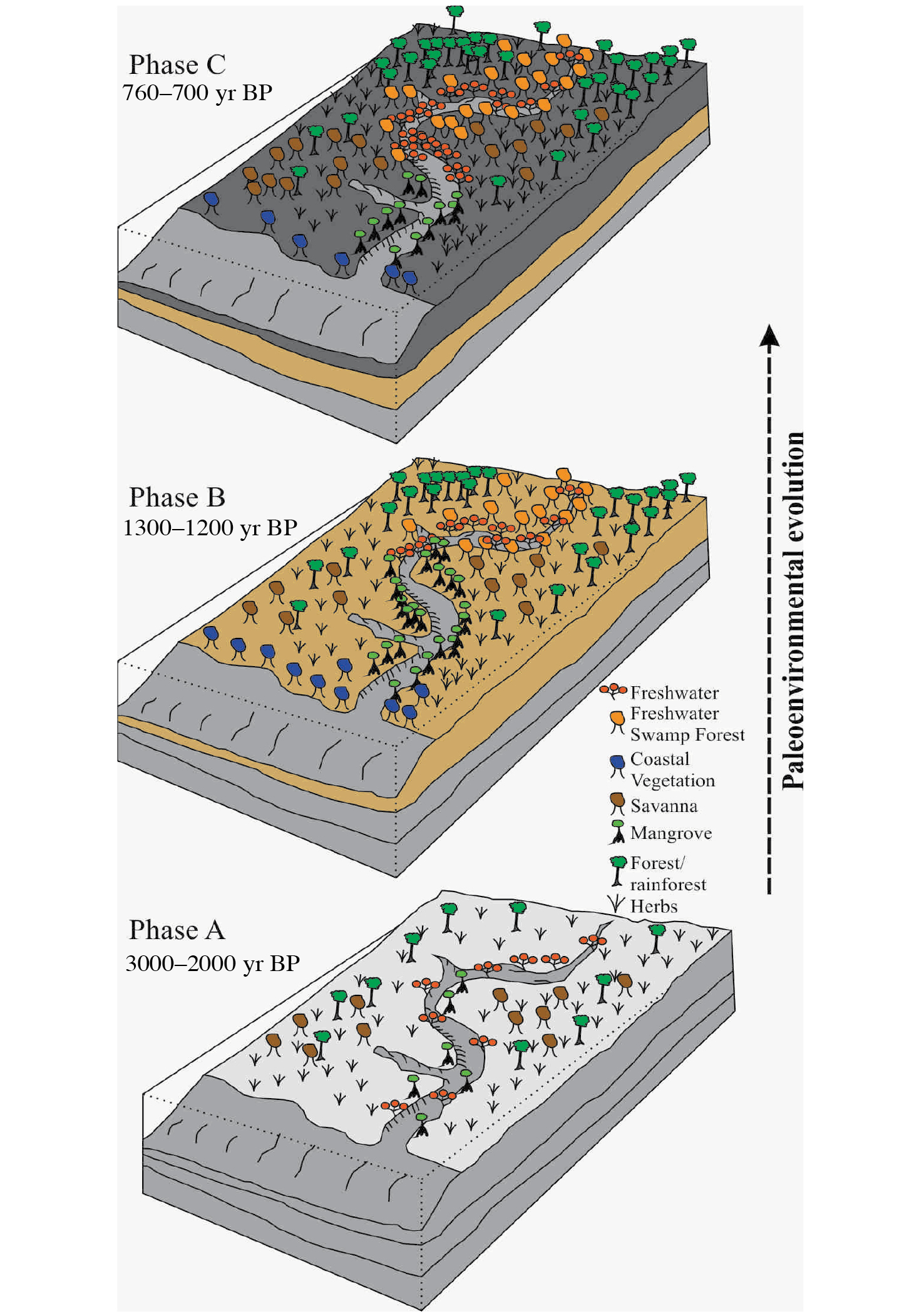- Home
- Publications
- PAGES Magazine
- Paleoenvironmental Change and Human Activity At Okomu National Park, Nigeria
Paleoenvironmental change and human activity at Okomu National Park, Nigeria
Emuobosa A. Orijemie, T.O. Ayelagbe, A.S. Diya, A.J. Ibirogba and E.T. Olaleye
Past Global Changes Magazine
31(1)
24-25
2023
We studied palynological and archaeological proxies to reconstruct the environmental and human–ecological history of the Okomu National Park in Nigeria. We observed distinct environmental phases characterized by the interplay between mangroves, freshwater forests and human influence.
Here, we show the results of some environmental archaeological investigations carried out in the rainforests of Okomu National Park (ONP), located 60 km northwest of Benin City in southern Nigeria. The ONP is a small area within the Okomu Forest Reserve (OFR); a forest block of about 1238 km2 (White and Oates 1999; Fig. 1), and remains a fully protected park. Nowadays, the vegetation consists of Guinea–Congo lowland rainforest, including areas of mangrove swamp forest, freshwater swamp forest, high forest, secondary forest, and open scrub. Some of the most common trees are Bombax buonopozense, Celtis zenkeri, Triplochiton scleroxylon, Antiaris africana, Pycnanthus angolensis and Alstonia congensis.
Previous studies in the area (Jones 1955, 1956; White and Oates 1999) reported the occurrence of charcoal and pottery based on dugouts from several pits in compartments 43, 44, 65, and 86 in the park. According to the report, the pits showed three distinct layers. The deepest layer (100–50 cm) had only charcoal, the second layer (50–20 cm) had charcoal, charred palm kernels and pottery. The third and shallowest layer (20–0 cm) lacked any cultural, charred or microfossil remains, which was interpreted as an abandonment period. Based on these results, Jones (1956) and White and Oates (1999) stated that the landscape of the ONP was not always a rainforest, but must have been occupied by farmlands and villages in the past. Furthermore, charcoal samples collected from compartments 86 and 65 at depths of 20 cm and 28–20 cm yielded radiocarbon dates of 760 ±50 yr BP and 700 ±60 yr BP, respectively (White and Oates 1999). This indicated that ONP was abandoned about 760–700 years ago (12th–14th centuries CE) (White and Oates 1999). The question that arises is why these settlers left the area. The abandonment event has been attributed to at least three possible factors, namely (1) climate change; (2) epidemic; and/or (3) the war between the kingdom of Benin and Udo, a city-state on the northernmost part of the ONP (Jones 1956), which occurred during the late 13th century. However, these hypotheses remain untested. Therefore, this study was designed to reconstruct the environmental and human-occupation history of the ONP using palynological and archaeological data.
Palynological and archaeological investigations
For the palynological component, we collected sediment cores from Lakes 90, 61 and 52 in the ONP and analyzed the pollen, spores, diatoms and charcoal to reconstruct the park’s environmental history. A one-meter square test pit (60 cm in depth) archaeological excavation was also conducted on compartment 65 to understand the occurrence and distribution of the cultural material in that part of the ONP.
The analyses of samples for palynological content yielded pollen grains, pteridophyte and fungal spores, algae and the lacustrine diatom Aulacoseira sp., which were used to distinguish three environmental phases; A, B and C (Fig. 2). For ease of interpretation, the pollen and spores were grouped into six ecological classes, namely mangrove swamp forest, coastal vegetation, freshwater swamp forest, freshwater, lowland rainforest and savanna. The earliest phase (A), was identified only in Lake 90 and was characterized by the presence of mangrove swamp forest, some secondary forest and freshwater taxa. By comparing this pollen assemblage with data from other sites in southern Nigeria and West Africa (Sowunmi 2004; Tossou et al. 2008), we interpreted that Phase A must have occurred between 3000 yr BP and 2000 yr BP. The intermediate phase (B), characterized by mangroves, freshwater and swamp forests taxa, and present in all the studied lakes, was interpreted as the first development of the rainforests. This development likely occurred between 1300 yr BP and 1200 yr BP (Orijemie 2020). We recovered pollen remains typical of anthropogenic disturbance of natural vegetation (Asteraceae), and economic plants (Vernonia amygdalina, Zanthozylum cf. zanthoxyloides, Spondias mombin and Parkia biglobosa) at a depth of 0.9–0.8 m in sediments of Lake 90 which corresponded to the terminal period of Phase B. These findings were interpreted as indicative of the presence of humans in Okomu. During the third phase (C), which was identified in all the lakes, there is a decline of the mangroves and secondary forest plants (Elaeis guineensis and Alchornea sp.), while rainforest taxa showed an increase. This vegetation change represents a marked decrease in human activities, and, hence, a regeneration of the rainforest at ca. 760–700 yrs BP.
The excavations in the test pit revealed three distinct stratigraphic layers. The deepest layer (60–40 cm) was devoid of artefacts, although we found a relatively high amount of charcoal particles. The occurrence of charcoal could either be of anthropogenic or natural origin. The remains of potsherds, charred palm kernels (Elaeis guineensis) and the cranial bone of catfish (Clarias sp.) in the second layer (40–20 cm) suggest the presence of settlers who carried out some agricultural and fishing activities. The third stratigraphic layer (20–0 cm) did not have any palynological or archaeological remains. This last sediment horizon probably represents the period when the Okomu area was abandoned, allowing the forest to regenerate.
Human occupation of Okomu National Park
The archaeological data suggest the presence of humans in the ONP at least between the 12th and 14th centuries CE, which agrees with previous findings by Jones (1956), and White and Oates (1999) about human occupation in this area. Palynological evidence from the region also supports this chronology, as sediment cores from Okomu Lakes 90, 61 and 52 showed human presence at depth 90–80 cm of Lake 90, 50–0 cm of Lake 61, and 45–0 cm of Lake 52 sediment cores. This is the first time that pollen indicators of human disturbance and economic plants are documented in the ONP. Furthermore, the distribution of archaeological materials across a large area, stretching over 15 km, also provides unique evidence that the ONP was a "densely populated and intensively cultivated landscape" (White and Oates 1999) before the final abandonment during, or shortly after, the 14th century CE.
The Okomu abandonment event
As indicated earlier, the abandonment event has been attributed to at least three possible factors, namely (1) climate change; (2) epidemic; and/or (3) the war between Benin and Udo. There are reports of the occurrence of a dry climate in West Africa during the 14th–16th centuries CE (Lézine et al. 2019; Logan and Stahl 2017) that had significant demographic impact in the region. However, this dry phase has not been identified in palynological records from the Okomu sediment cores, which showed an increase in rainforest taxa during that time. The outbreak of an epidemic has been documented in the location of Iguowan, within the ONP, but 200–150 yrs ago (Jones 1956), after the abandonment of the Okomu region. Udo rivalled Benin for centuries, but it was destroyed twice by the forces of the ruler of Benin (called Oba); first by Oba Oguola at around 1285 CE (Egharevba 1960), and second by Oba Esigie at ca. 1520 CE (Jones 1956). The warfare in ca. 1285 CE would be contemporaneous with the period when the Okomu area was abandoned, and when the rainforest regenerated and became floristically diverse, as noted in the pollen record.
This work investigated the environmental and human–environment history of the Okomu National Park. We showed, using a combination of palynological evidence and archaeological data from diverse types of sediment records in the Okomu forest, that there were landscape changes due to a combination of natural and anthropogenic factors. More importantly, we observed clear evidence that the area was inhabited until the 14th century CE when it was abandoned, most likely because of the warfare between the kingdoms of Benin and Udo.
Acknowledgements
Appreciations go to Alhaji Ibrahim Musa Goni, the Conservator General of the Nigeria National Park Service, who provided approval for this research. We gratefully acknowledge the Conservator of Parks of the Okomu National Park, Mr. Adeniyi Tesleem Kareem, and members of staff who assisted our team during our visit to Okomu in 2019. Thanks are due to Prof. M. Adebisi Sowunmi who provided the sediment core samples from Lake 90.
affiliations
1Department of Archaeology and Anthropology, University of Ibadan, Nigeria
2Department of Earth and Environmental Sciences, Columbia University, New York, USA
contact
Emuobosa A. Orijemie: orijemie17 gmail.com
gmail.com
references
Egharevba JU (1960) A Short History of Benin. Ibadan University Press, 101 pp
Jones EW (1955) J Ecol 43: 564-594
Jones EW (1956) J Ecol 44: 83-117
Lézine A-M et al. (2019) Rev Palaeobot Palynol 27(1): 1-7
Logan AL, Stahl AB (2017) J Archaeol Method Theory 24(4): 1356-1399

